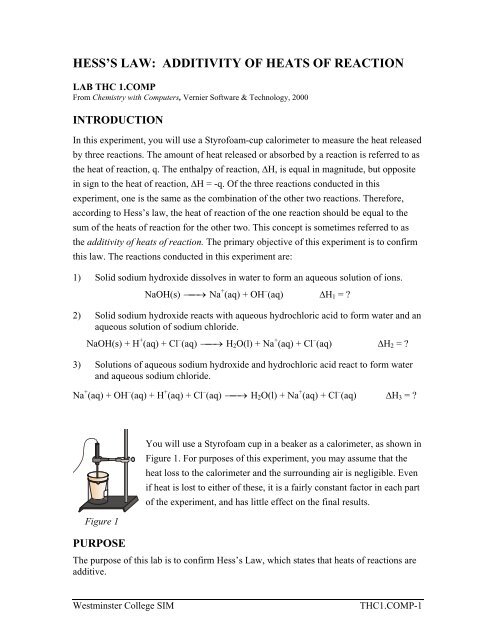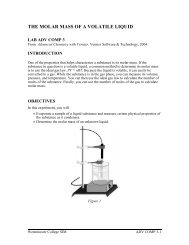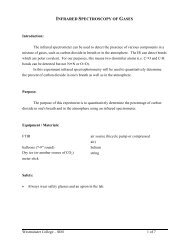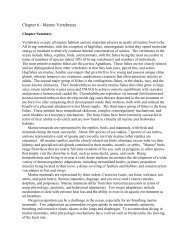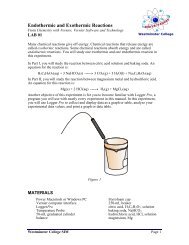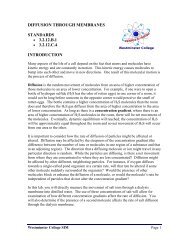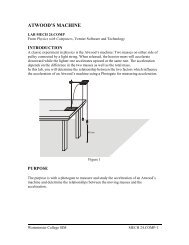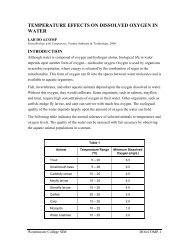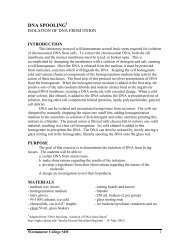hess's law: additivity of heats of reaction - Westminster College
hess's law: additivity of heats of reaction - Westminster College
hess's law: additivity of heats of reaction - Westminster College
- No tags were found...
You also want an ePaper? Increase the reach of your titles
YUMPU automatically turns print PDFs into web optimized ePapers that Google loves.
Hess’s Law: Additivity <strong>of</strong> Heats <strong>of</strong> Reaction5. Click on Collect to begin data collection and obtain the initial temperature, t 1. It maytake several seconds for the Temperature Probe to equilibrate at the temperature <strong>of</strong>the solution.6. After three or four readings at the same temperature have been obtained, add thesolid NaOH to the Styr<strong>of</strong>oam cup.7. Using the stirring rod, stir continuously for the remainder <strong>of</strong> the 200 seconds oruntil the temperature maximizes. Note: As soon as the temperature has begun todrop after reaching a maximum, you may terminate the trial by clicking Stop .8. Examine the initial readings in the Table window to determine the initialtemperature, t 1 .9. To determine the final temperature, t 2 , click the Statistics button, . The maximumtemperature is listed in the statistics box on the graph.10. Record t 1 and t 2 in your data table.11. Rinse and dry the Temperature Probe, Styr<strong>of</strong>oam cup, and stirring rod. Dispose <strong>of</strong>the solution as directed by your instructor.Reaction 212. Repeat Steps 2-11 using 100.0 mL <strong>of</strong> 0.50 M hydrochloric acid, HCl, instead <strong>of</strong>water.Reaction 313. Repeat Steps 2-11, initially measuring out 50.0 mL <strong>of</strong> 1.0 M HCl (instead <strong>of</strong> water)into the Styr<strong>of</strong>oam calorimeter. In Step 4, instead <strong>of</strong> solid NaOH, measure 50.0 mL<strong>of</strong> 1.0 M NaOH solution into a graduated cylinder.<strong>Westminster</strong> <strong>College</strong> SIMTHC1.COMP-3
Hess’s Law: Additivity <strong>of</strong> Heats <strong>of</strong> ReactionDATA SHEETName ________________________Name ________________________Period _______ Class ___________Date ___________HESS’S LAW: ADDITIVITY OF HEATS OF REACTIONDATA TABLEReaction 1 Reaction 2 Reaction 3Mass <strong>of</strong> solidNaOH g g(no solid NaOH mass)Mass (total) <strong>of</strong>solution* g g gFinaltemperature, t 2 °C °C °CInitialtemperature, t 1°C °C °CChange intemperature, ∆t °C °C °C*Assume the density <strong>of</strong> each solution is 1.00 g/mL.CALCULATION TABLEReaction 1 Reaction 2 Reaction 3Heat, qΕnthalpy, ∆HMoles <strong>of</strong> NaOH∆H/molkJ kJ kJkJ kJ kJmol mol molkJ/mol kJ/mol kJ/molExperimental valueAccepted valuekJ/molkJ/molPercent error %<strong>Westminster</strong> <strong>College</strong> SIMTHC1.COMP-4
Hess’s Law: Additivity <strong>of</strong> Heats <strong>of</strong> ReactionPROCESSING THE DATA1. Determine the mass <strong>of</strong> 100 mL <strong>of</strong> solution for each <strong>reaction</strong> (assume the density <strong>of</strong>each solution is 1.00 g/mL).2. Determine the temperature change, ∆t, for each <strong>reaction</strong>.3. Calculate the heat released by each <strong>reaction</strong>, q, using the formula:q = Cp•m•∆t (C p = 4.18 J/g°C)Convert joules to kJ in your final answer.4. Find ∆H ( ∆H = -q ).<strong>Westminster</strong> <strong>College</strong> SIMTHC1.COMP-5
Hess’s Law: Additivity <strong>of</strong> Heats <strong>of</strong> Reaction5. Calculate moles <strong>of</strong> NaOH used in each <strong>reaction</strong>. In Reactions 1 and 2, this can befound from the mass <strong>of</strong> the NaOH. In Reaction 3, it can be found using themolarity, M, <strong>of</strong> the NaOH and its volume, in L.6. Use the results <strong>of</strong> the Step 4 and Step 5 calculations to determine ∆H/mol NaOH ineach <strong>of</strong> the three <strong>reaction</strong>s.7. To verify the results <strong>of</strong> the experiment, combine the heat <strong>of</strong> <strong>reaction</strong> (∆H/mol) forReaction 1 and Reaction 3. This sum should be similar to the heat <strong>of</strong> <strong>reaction</strong>(∆H/mol) for Reaction 2. Using the value in Reaction 2 as the accepted value andthe sum <strong>of</strong> Reactions 1 and 3 as the experimental value, find the percent error forthe experiment.<strong>Westminster</strong> <strong>College</strong> SIMTHC1.COMP-6


